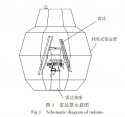I can't read all the technical specifications posted by Snake, but definitely it's outlining Active functions for Zaslon MF on X, S bands, and different Passive functions on L, S, X, C, Ku, followed by another set of (passive) functions on S, C, X, Ku and finally one last set on just X and Ku.
They displayed the specs but also along with the whole integrated mast. The integrated mast has TK-25E-5, which is a brand new ESM set. See the large chunky thing below the navigation radar. ECM and ESM sets are usually hung around the sides of the mast, for Russian warships, a practice that is also followed by the PLAN.

Data is scant I only have this.
TK-25E-5 ECM system is designed to intercept emissions of airborne and shipborne tar-get acquisition radars, weapons control radars and anti-ship missile radar seekers, to perform automatic signal classification, to determine most dangerous approaches of attacks against the ship, and to provide jamming in threat directions.TK-25E-5’s configuration depends on carrier-ship type and displacement. Source scribd.com
GENERAL DATA:
Type: ESM Altitude Max: 0 m
Range Max: 926 km Altitude Min: 0 m
Range Min: 0 km Generation: Early 2000s
SENSORS / EW:
TK-25-2 ESM – ESM
Role: ELINT w/ OTH Targeting
Max Range: 926 km
Source cmano-db.com
The ECM and ESM sets are all over the mast, right next to the Zaslons. Far more likely the passive and the jamming capabilities are from the TK-25E-5 set. This version of the TK-25 is so brand new, its not seen on the Admiral Gorshkov class. Only the Project 20385 has this, and my bet is the new EW suite will also make its appearance in future batches of the Gorshkov, as well with the Zaslon and the integrated mast.

Back on topic now...
If 2 face radar can continuously illuminate targets, is there any immediate need for active seeker missile?
There is already a patent to what you are saying "If 2 face radar can continuously illuminate targets,"
Its already expired however. But I doubt the two faced radar you see on Weapons Test Ship 892 does missile target illumination because its going to be working on the S-band if its meant as a Type 382 "Top Plate" replacement, and is meant primarily as a pulse search radar. For missile target illumination, the radar has to be a continuous wave X-band radar. I also doubt that the other two faced radar, the one you see on the Type 075, works as a continuous wave X-band radar, and even if one side is an X-band the other side isn't.
What the two sided S-band radar can do is tell the active missile where the target is via datalink, and guide the missile on its mid phase towards the target till the target is at the range of the active radar seeker on the missile, and missile activates it. Do note that active seekers tend to have a short seeker range, due to the size of the antenna, which is small, being battery powered, which limits your power, and uses high X, K or Ku band frequency for angular resolution. So its the job of the main radar to bring the active seeker missile to within range of its own seeker.
Yes. Active seekers allow for a high number of simultaneous engagement, and engagement beyond the horizon.
Just to toss this in. Remember the Chinese lantern mock up in Wuhan? That's supposed to contain a two faced radar. Given the size of it, I think that's the one that ended up on the Type 075 but the radome is cancelled.
















